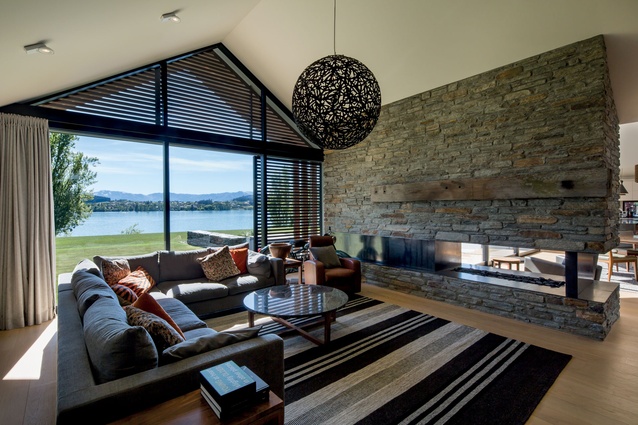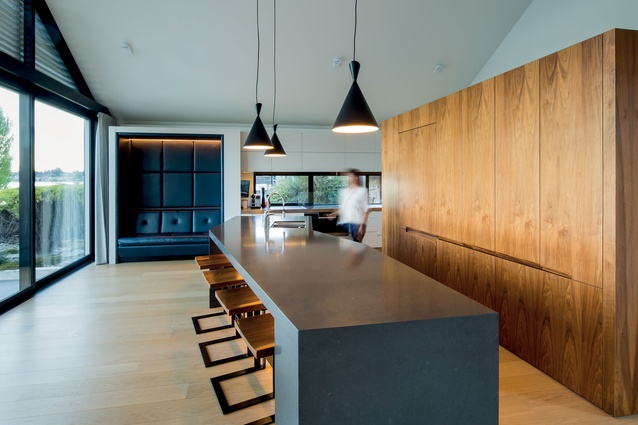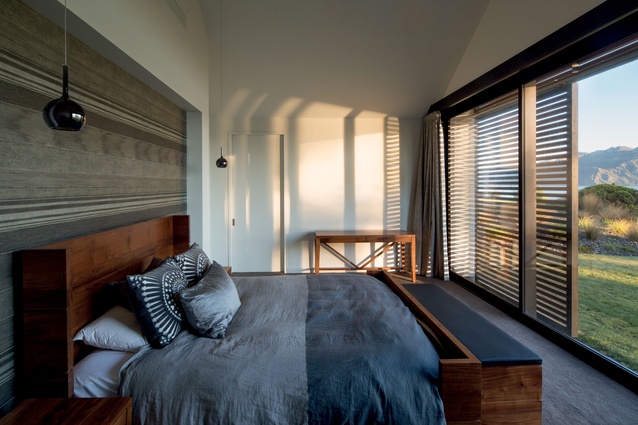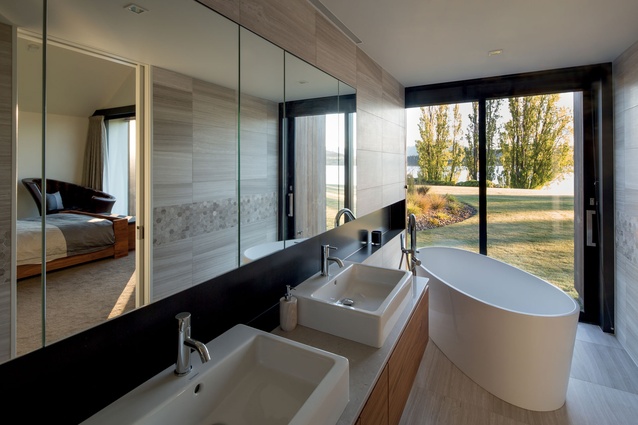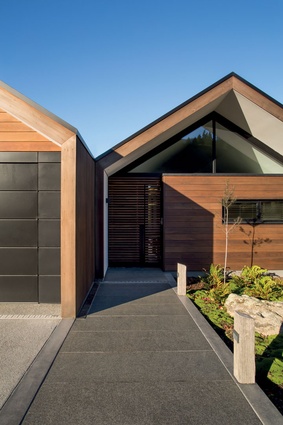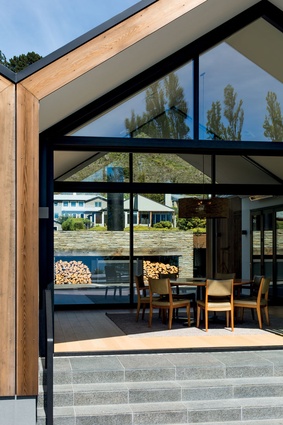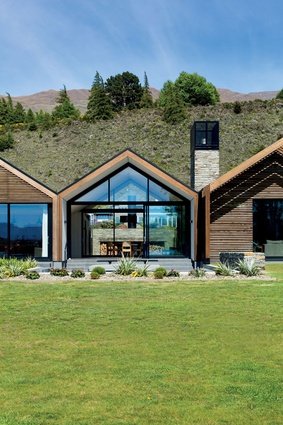Series of pavilions: Sunrise Bay House
Overlooking Ruby Island on Lake Wanaka, a young family’s holiday home features four gabled timber forms, their peaks emulating the snow-capped backdrop of Mount Gold.
When you have an outlook towards Ruby Island – a jewel in sparkling Lake Wanaka – you want to make the most of it. This Central Otago holiday retreat for a couple from Christchurch and their three young children has a privileged position on one of the last remaining waterfront blocks on the western edge of the lake. But Ian Adamson and Hilton Miller from Warren and Mahoney resisted the temptation to design an elongated home facing the view.
“We conceived a series of pavilions, which slide past each other to provide a level of interest and set up important relationships with external spaces,” says Ian. Seems simple enough, but when the idea was first presented, it wasn’t immediately embraced. “I got a bit of a shock,” says one of the owners. “To me, it looked like four carriages lined up.” So a journey of discovery began, in which doubt turned to faith – and the outcome is loved by the owners, admired by others and makes a solid contribution to the built community.

Four gabled forms, equal in volume, sit naturally in the majestic landscape, their peaks emulating the snow-capped backdrop of Mount Gold, their earth-toned cladding low-key to the lakefront. The arrangement of this house isn’t the classic one ‘pod’ for living, with distinctive areas for sleeping and living and so on. For although, at first glance, they appear as separate elements, internally there are sliding doors and apertures that link each to the other. “Each pavilion in its length is not dedicated to one use; in that way, they’re not purist,” says Hilton.
Utilitarian ‘boxes’ beneath soaring rooflines are inserted in the spatial arrangement: one contains an office, another a media room, a third houses the powder room. This approach (which the owner calls ‘a house within a house’) does not block off space but allows light to flood in through full-height glazing.
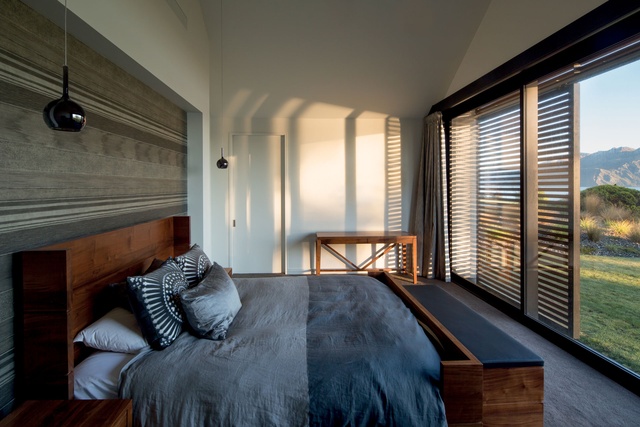
The interiors are texturally rich, from the cool smoothness of the engineered-stone bench to the figured grain of walnut cabinetry; from the solidity of an Otago schist fireplace that slices between the dining and living zone to the softness of a built-in leather alcove alongside the kitchen. “It’s like the back seat of a car,” explains the owner. “It’s upholstered in dark-blue leather, has a fold-down drinks’ station and you can sit here and see right up to Minaret Station.”
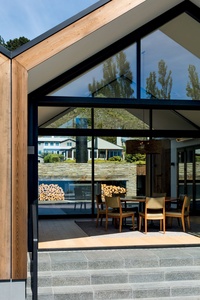
As a quadruple line-up, the pavilions share like-minded architectural genes – a shell of cedar with dark tray roofing and an underbelly of white-painted soffits and walls. Yet, as in any family, there are unique traits. One pavilion has glazing each side – unfettered by solar shading. “It was important to maintain a sense of the view from the public realm behind the house,” says Ian. On another, the gable frames extend beyond the eaves, a skeleton of structure. “They are an additional layer of sun protection and give the front façade more depth,” explains Hilton.
Privacy was another imperative, from neighbours and those who passed by on the reserve in front of the home. Here’s the conundrum: how to maintain the vista while keeping outdoor living secluded. The architects’ response was an alfresco dining area and sunken spa, one step down from ground level. The grass rolls straight out to the reserve; this way the owners have an unobstructed lake view but are protected from the wind and public gaze.
Although there are five bedrooms, two living zones and garaging for four cars, the staggered arrangement breaks up the bulk of the 420m2 home. The walls of the house embrace a sheltered internal courtyard on three sides. “To the west, there’s a late-day courtyard with a fireplace,” says Ian. The aspect here is through the glazed pavilion to the lake. The owners can relax with sundowners and take in the serenity of the lapping waters – or the craziness of swim events, such as The Big Ruby, where, each summer, competitors brave freezing temperatures to swim two laps around Ruby Island’s pebble-dashed shores.

“Every day we spend here, people come up to ask us about the house – we even had a bride taking selfies.” Fact is, as much as he loves the result, the owner, dubious at first, enjoyed the process. “It has taught me to trust the experts and just roll with it,” he says.
MATERIAL SELECTOR
Hilton Miller discusses the design and materials used in Sunrise Bay House.
How did you build natural and local materials into the design?
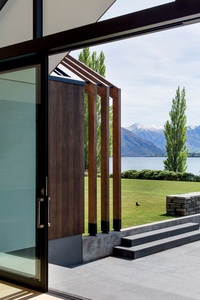
Placement and context is immensely important; the chimney anchors the building, so a heavy material such as schist was the perfect choice. Cedar cladding communicates with the environment beyond and complements neighbouring buildings, while internally, timber ensures a tactile finish and morphs into a richer walnut.
The schist fireplace is an interesting feature.
Yes, the double-sided fireplace opens visually between the dining and living areas. Both inside and outside fires incorporate recycled timber beams sourced from the historic Kurow bridges – hand selected for an exact fit.
What was the idea behind the timber solar shading?
Shading screens from shaped cedar battens match the cladding. It was important they remained flush with the gable above, adding mass to the elevation and increasing the overall depth of shading. Lower sliding screens allow the owner personalised shading and privacy.


